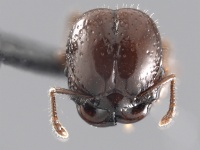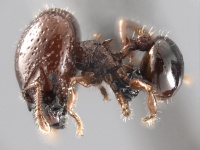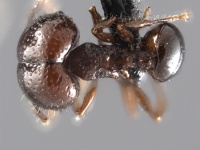Acanthomyrmex mindanao
| Acanthomyrmex mindanao | |
|---|---|

| |
| Montage view of major worker | |
| Scientific classification | |
| Kingdom: | Animalia |
| Phylum: | Arthropoda |
| Class: | Insecta |
| Order: | Hymenoptera |
| Family: | Formicidae |
| Subfamily: | Myrmicinae |
| Tribe: | Myrmecinini |
| Genus: | Acanthomyrmex |
| Species: | A. mindanao |
| Binomial name | |
| Acanthomyrmex mindanao Moffett, 1986 | |
Found nesting in logs on the ground, Acanthomyrmex mindanao has small colonies of less than 50 workers.
Identification
Moffett (1986) - A member of the notabilis group. Minor Workers: Well developed small projecting lobes immediately on each side of medial hair on anterior margin of clypeus, funicular scrobes present. Major Worker: Postpetiole about as wide as long in dorsal view. Dorsum of head with large fovea.
Postpetiole in both castes approximately cuboidal, not conspicuously wider than deep in dorsal view; propodeal spines shorter than in Acanthomyrmex notabilis. Minors with posterior margin of head moderately concave in dorsal view, and with funicular scrobe present, although poorly developed; ventral mandible tooth usually present, and with strongly projecting medial clypeal lobes.
Philippine specimens are very similar to the type series, except for a Momungan major that is smaller (HW 1.64) and hairier than the paratype major. This major also has hypostomal teeth, and lacks a subpetiolar declivity. Ginoog worker specimens consistently lack the pair of hairs near the summit of the petiolar node which are usually present in specimens from other series. Color in a few specimens uniform yellow. Workers of a Sarawak series are the smallest recorded for this genus (HW 0.70 to 0.76 mm) and are significantly smaller than any of the Philippine specimens (HW 0.90 to 1.11 mm). These ants lack a ventral mandibular tooth, lack sublateral hairs on their petioles, and have the pilosity on their postpetioles reduced to two pairs of hairs dorsally and one lateral pair. The larger of the minor workers from the Philippines (HW > 1.05 mm) completely lack pronotal spines. Also, the same individuals have better developed ventral mandibular teeth than in other minors; their gasters are somewhat hairier and they have a more deeply engraved frontal sulcus. They therefore show some characteristics intermediate between the minor and major castes.
Keys including this Species
Distribution
PHILIPPINES: Lanao del Sur, Mindanao, MSU-Marawi (7°59'58.74N, 124°15'41.36E), 776 m, 24.iv.2010, coll. Malik Nagamora Jr., LSD Mindanao State University
Latitudinal Distribution Pattern
Latitudinal Range: 14.601871° to 14.601871°.
| North Temperate |
North Subtropical |
Tropical | South Subtropical |
South Temperate |
- Source: AntMaps
Distribution based on Regional Taxon Lists
Indo-Australian Region: Borneo, Indonesia, Malaysia, Philippines (type locality).
Distribution based on AntMaps
Distribution based on AntWeb specimens
Check data from AntWeb
Countries Occupied
| Number of countries occupied by this species based on AntWiki Regional Taxon Lists. In general, fewer countries occupied indicates a narrower range, while more countries indicates a more widespread species. |

|
Estimated Abundance
| Relative abundance based on number of AntMaps records per species (this species within the purple bar). Fewer records (to the left) indicates a less abundant/encountered species while more records (to the right) indicates more abundant/encountered species. |

|
Habitat
Tropical forests
Abundance
Uncommon in collections.
Biology
Assumed majors crush seeds and defend the colony. The minors forage for seeds.
Nesting Habits
Nest in logs on the ground.
- Queen type: ergatoid (Moffett 1986, Yamada et al. 2018) (Yamada et al. 2018 suggest variation in minor workers examined and noted by Moffett indicates these specimens were minors and ergatoid queens.)
- Mean colony size: <50 (Moffett 1986)
- Diet: seed harvestor (Moffet 1986) (seeds are known to be part of diet)
Castes
Dimorphic ants with short, stocky majors and spiny minors.
- Minor Worker
 
| |
| . | Owned by Museum of Comparative Zoology. |
Nomenclature
The following information is derived from Barry Bolton's Online Catalogue of the Ants of the World.
- mindanao. Acanthomyrmex mindanao Moffett, 1986c: 82, figs. 39E, 51-56 (s.w.) PHILIPPINES (Mindanao).
- Type-material: holotype minor worker, 1 paratype major worker, 4 paratype minor workers.
- Type-locality: holotype Philippines: Mindanao, Davao Prov., E slope Mt McKinley, 3300 ft, 30.viii.1946, lot 33, under bark (F.G. Werner); paratypes with same data.
- Type-depository: MCZC.
- Status as species: Bolton, 1995b: 53; Pfeiffer, et al. 2011: 44; Yamada, Ito, et al. 2018: 10.
- Distribution: Malaysia (Sarawak), Philippines (Mindanao).
Description
Worker
Minor Holotype (HW 1.05 mm) and four minor paratypes measure HW 0.98 to 1.06, HL 0.84 to 0.91 (CI 114 to 117), ML 0.65 to 0.71 (MI 75 to 78), SL 0.83 to 0.88 (SI 81 to 84), EL 0.19 to 0.22, HFL 0.90 to 0.95 (FLI 104 to 107; FWI 21 to 22) mm. Head in full-face view appearing flattened or slightly concave across posterior margin . Head widest above the eyes. Head with oval foveae having thick walls; dorsally the longest hairs extend 0.08 to 0.10 mm. Scrobes bent sharply downwards posteriorly, forming a shallow groove for funiculus extending dorsad to each eye alongside groove for scape. Scapes relatively short (SI < 90), so that when retracted to scrobes, scapes barely extend beyond back margin of head. Mandibles often with relatively few denticles (usually eight or less; eight to 12 in most specimens in other species). Clypeal index 129 to 134. Lobe to each side of medial clypeal hair strongly produced, and more approximate to hair than in other species; lateral clypeal hairs not in a completely enclosed fovea. Smooth medial area of clypeus not bordered laterally by distinct rugae. Mandibles with a tiny but distinct ventral tooth. Spines on trunk short relative to other species, propodeal spines conspicuously longer than pronotal spines, and are virtually straight to feebly curved caudad; pronotal spines very short and stubby (lacking in larger minor workers in some other series: see below). Pronotal spines without conspicuous hairs. Pronotal angle never drawn out into a feeble tooth. Propodeal declivity bordered on each side by one rugum or possibly two adjacent rugae (second rugum poorly developed when present). Node of petiole as in Figure 39E, PWI narrow (45 to 64); caudal face of node usually with a pair of hairs near summit (absent in Fig. 56), in addition to the single pair found lower on the same face of node in this and most other Acanthomyrmex. Anterior peduncle of petiole relatively short and deep as in A. notabilis, and with lateral petiolar hairs present (but sometimes hair missing from one side of petiole); sublateral pair lacking. Subpetiolar declivity present. Postpetiole subrec tangular, almost as long as it is wide in dorsal view, and with two or three longitudinal rugae on each side; hairy dorsally. Femora only with basal hairs or having one to three additional hairs, and with ventral surfaces distinctly concave; hind femora relatively short (FLI < llO). Orange yellow to reddish orange, with legs lighter yellow.
Major Paratype measures HW 1.98, HL 2.16 (Cl 92), SL 0.90 (SI 46), EL 0.26, HFL 1.00 (FLI 46; FWI 20) mm. Foveae on head smaller and shallower than in A. notabilis (somewhat larger and denser beneath head), numerous except very few present in area between antennal scrobes. Pilosity present on head, but more scattered than in A. notabilis majors. Cephalic hollow conspicuous. A darkly pigmented streak extends to hollow from dorsum of head; wide medial sulcus conspicuous from hollow to frontal area. Forward margin of clypeus with a medial projection. Hypostomal teeth absent. Propodeal spines short and curved caudad. Color as in minor workers, but head a richer orange, antennae a contrasting shade of yellow.
Type Material
Holotype 1 minor. Paratypes: 4 minors and 1 major deposited in the Harvard University Museum of Comparative Zoology. Mindanao, Davao Province, east slope of Mt. McKinley, 3,300 feet, lot 33, under bark, 30 August 1946 (F.G. Werner)
Etymology
The specific name is a noun in apposition after the type locality
References
- Moffett, M.W. 1986c. Revision of the myrmicine genus Acanthomyrmex. Bulletin of the Museum of Comparative Zoology. 151:55-89. [15.viii.1986.]
- General, D.E.M. 2021. A preliminary checklist of the ants (Hymenoptera: Formicidae) of the Mt. Pantaron Range, Bukidnon Province, Mindanao Island, Philippines. Halteres, 12:4-14 (doi:10.5281/ZENODO.5371745).
- Yamada, A., Ito, F., Hashim, R. and K. Eguchi. 2018. Queen polymorphism in Acanthomyrmex careoscrobis Moffett, 1986 in Peninsular Malaysia (Hymenoptera: Formicidae: Myrmicinae), with descriptions of hitherto unknown female castes and males. Asian Myrmecology. 10:e010009:1-14. doi:10.20362/am.010009
References based on Global Ant Biodiversity Informatics
- General D. M., and G. D. Alpert. 2012. A synoptic review of the ant genera (Hymenoptera, Formicidae) of the Philippines. Zookeys 200: 1-111.
- Moffett, M. 1986. Revision of the myrmicinae genus Acanthomyrmex (Hymenoptera: Formicidae). Bulletin of the Museum of Comparative Zoology 151(2): 55-89
- Moffett, M. W. 1986. Revision of the myrmicine genus Acanthomyrmex (Hymenoptera: Formicidae). Bulletin of the Museum of Comparative Zoology 151:55-89.
- Pfeiffer M.; Mezger, D.; Hosoishi, S.; Bakhtiar, E. Y.; Kohout, R. J. 2011. The Formicidae of Borneo (Insecta: Hymenoptera): a preliminary species list. Asian Myrmecology 4:9-58

